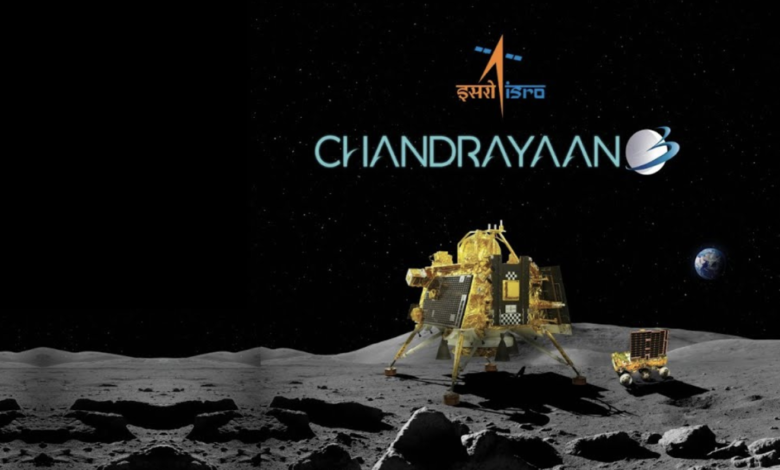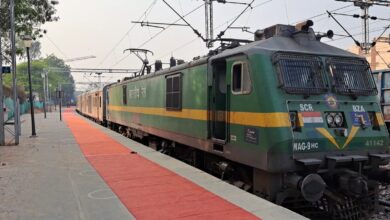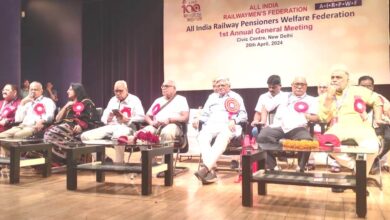Historic Triumph: Chandrayaan-3 Achieves Soft Moon Landing; PM Modi Applauds ISRO’s Success
Prime Minister Narendra Modi Extends Congratulations to ISRO on This Momentous Occasion

In a monumental achievement, India’s Chandrayaan-3 has executed a graceful soft landing on the lunar surface. This historic milestone is being celebrated as a moment of pride and a leap forward for India’s space endeavors. Prime Minister Narendra Modi has personally acknowledged this achievement, extending his heartfelt congratulations to the Indian Space Research Organisation (ISRO).
Taking to the social media platform Twitter, PM Modi expressed his elation, stating, “Congratulations to @isro for the remarkable success of Chandrayaan-3 lunar mission. India is now on the Moon. This moment walks the path of victory.”
Furthermore, the Prime Minister shared his deep personal connection with the Chandrayaan mission, asserting, “Just like every fellow citizen, my heart was also deeply invested in the Chandrayaan journey.”
As the nation rejoices in this remarkable accomplishment, jubilation reverberates in every corner of the country. PM Modi eloquently encapsulated the prevailing sentiment, saying, “With the creation of new history, every Indian is immersed in joy, and festivities have commenced in every household.”
Chandrayaan-3, following the trailblazing success of Chandrayaan-2, emerges as a beacon of India’s prowess in achieving a precise and secure landing on the lunar terrain. This mission is distinguished by its intricate Lander and Rover design, aimed at seamlessly transitioning from landing to traversing the moon’s surface.
A significant stride forward, the propulsion module of Chandrayaan-3 adeptly navigated the journey, propelling the Lander and Rover configurations into an orbit situated approximately 100 kilometers above the moon’s surface. This propulsion module has also been furnished with a payload named “Spectro-polarimetry of Habitable Planet Earth” (SHAPE), enabling a comprehensive study of Earth through the unique lens of lunar orbit.
The Lander payloads comprise a suite of cutting-edge instruments, encompassing Chandra’s Surface Thermophysical Experiment (ChaSTE), devised to gauge temperature and thermal conductivity. The Instrument for Lunar Seismic Activity (ILSA) is strategically positioned to monitor seismic activity in the vicinity of the landing site. Integration of a Langmuir Probe (LP) allows for plasma density variation estimation. Additionally, the incorporation of a passive Laser Retroreflector Array from NASA facilitates meticulous lunar laser ranging studies.
The Rover payloads are equally sophisticated, with the Alpha Particle X-ray Spectrometer (APXS) and Laser Induced Breakdown Spectroscope (LIBS) synergistically unraveling the elemental composition within the landing site’s vicinity.
Chandrayaan-3’s composition comprises an indigenous Lander module (LM), Propulsion module (PM), and Rover, all engineered to showcase and pioneer revolutionary technologies for interplanetary missions. The Lander module stands as a testament to its ability to gently touchdown at predetermined lunar coordinates, thereby deploying the Rover to undertake in-situ chemical analysis during its exploratory journey. Both the Lander and Rover house scientific payloads that will directly engage in experiments on the lunar surface.
The Propulsion Module (PM) plays a pivotal role in ferrying the Lander module from its launch vehicle injection point to the final lunar orbit situated at an approximate distance of 100 kilometers. Subsequently, the Lander module is detached from the Propulsion Module. Significantly, the Propulsion Module also carries a scientific payload, intended for operational deployment post the Lander Module’s separation.
GSLV-Mk3 has been assigned the responsibility of serving as the designated launcher for Chandrayaan-3. This launcher is entrusted with positioning the integrated module in an Elliptic Parking Orbit (EPO), characterized by dimensions of approximately 170 x 36500 kilometers.
The mission’s overarching objectives encompass the demonstration of a safe and gentle lunar landing, the exhibition of autonomous rover mobility on the moon’s surface, and the execution of in-situ scientific experiments. The Lander module is equipped with an array of advanced technologies, encompassing laser and RF-based altimeters, laser Doppler velocimeters, laser gyro-based inertial referencing systems, and an assortment of thrusters for precise propulsion control. This suite of technologies is fortified by state-of-the-art navigation, guidance, and control systems, hazard detection and avoidance mechanisms, and an intricate landing leg mechanism.
To validate the efficacy of these advanced technologies within Earth’s environment, ISRO has meticulously orchestrated a series of specialized Lander tests, all of which have been executed with resounding success. These tests include integrated cold tests conducted to evaluate sensor and navigation performance using a helicopter platform, integrated hot tests designed to assess closed-loop performance with sensors, actuators, and guidance systems using a tower crane, and comprehensive Lander leg mechanism tests performed on a lunar simulant test bed, simulating various touchdown scenarios.




